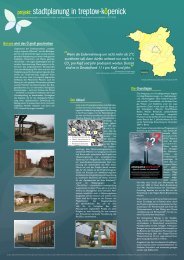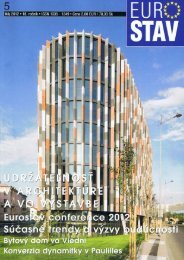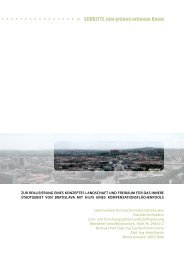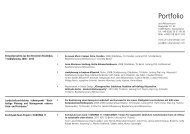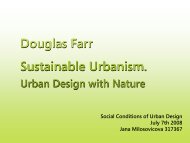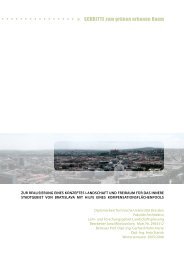Thesis document - Jana Milosovicova - Urban Design English
Thesis document - Jana Milosovicova - Urban Design English
Thesis document - Jana Milosovicova - Urban Design English
- No tags were found...
You also want an ePaper? Increase the reach of your titles
YUMPU automatically turns print PDFs into web optimized ePapers that Google loves.
Type of landuseDirect impact and effects on climate,as well as the impact on water cycle,soils and vegetation (with consequencesfor climate)PrimaryclimaticfunctionMain CSUD action categories (for newdevelopments). 1Building areas with housing and/or commercial and mixed-use buildings (continued)Low-rise, detachedhousingareasFavourable microclimate, however havinglower population density and thus likely toconsume considerably more undevelopedland than a denser urban form, with obviousnegative consequences for climate.ImpactareaRise densities (preferably in the verticaldirection); green spaces between buildingsand, where paving unavoidable, usepermeable paving; green the roofs andfaçades; ; implement water bodies; collectrainwater and re-use it for green roofs andfaçade irrigation, for adiabatic cooling, foruse in buildings.Public buildingcomplexes(universities,research centres)Often situated in well-ventilated parklikecomplexes. Soil sealing rate dependson the exact purpose of the facility (e.g.research institutes may have more extensiveopen spaces for representativepurposes than universities, where a highfluctuation of students and thus higherrate of soil sealing might be needed);rainwater infiltration mostly on site, orinto rainwater basins that have environmentalas well as esthetical functions.ImpactareaAim at mixed-use; keep the buildingdimensions down to the necessary extent;green ospaces between buildings and,where paving unavoidable, use permeablepaving; green the roofs and façades;implement water bodies (on buildings ifno space on the street level) and collectrainwater and re-use it for green roofs andfaçade irrigation, for adiabatic cooling, foruse in buildings.Industrial areasAreas ofconcentratedcommerceand/or heavyindustryWaste artificial areas with very high ratioof non-permeable built surfaces (almost100% of all surfaces of buildings as wellas of spaces between them being sealed),usually well ventilated, however the heatemissions from buildings (emitted storageheat) and from anthropogenic activitiesconsiderably high.ImpactareaGreen of spaces between buildings anduse permeable paving when no danger ofthe pollution of soils; green the roofs andfaçades; collect rainwater and re-use it forgreen roofs and façade irrigation, for adiabaticcooling, for use in buildings.Traffic areas and road infrastructureMain roadsAlthough frequently accompanied byrobust vegetation, negative effects stillprevail: dispersion of air pollutants, 100%sealed surfaces, salts impinging into thesoils.ImpactareaRaise the albedo of the road surface, planthigh tree vegetation and involve vegetatedfilter strips for the catchment of pollutantsaccompanying the roads; for its coolingeffect, use the collected, filtered rainwaterfor road irrigation.Railway areasCool air transporting effects; extremeheating up on hot sunny days if darkmaterials (crushed stone or clinker) used;mostly accommodating random ruderalvegetation that in a little extent contributesto fresh air production.CompensationareaUse light coloured stone materials; connectwith adjacent built-up areas throughventilation lanes to take the highest advantageof the ventilation.1 The fields of actions vary for every category; although there are common built form arrangements than need to be considered for everyurban situation, as pointed out in section 2.2 “Basic energy, heat and water cycle characteristics”.78Climate Sensitive <strong>Urban</strong> <strong>Design</strong> in Moderate Climate Zone: Responding to Future Heat Waves. Case Study Berlin Heidestrasse/Europacity



